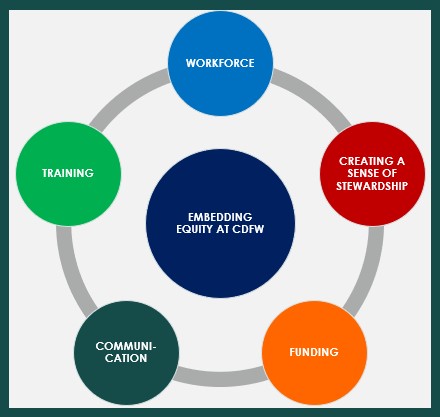
Downtown Sacramento from the Capitol building. (Photo: Norcal_kt, Shutterstock)
Is It Racist: A Look at State Agency Anti-Racism Plans
We all know now that California’s water is not racist
By Thomas Buckley, June 7, 2024 2:45 am
Thanks to the good people at the State Water Resources Control Board, we all know now that California’s water is not racist, or at least as racist as it supposedly used to be.
That’s all well and good – but what about the fish?
Or lottery tickets?
Or food?
Or California’s state-owned buildings?
Last year, the SWRCB approved its Racial Equity Action Plan and, so far, forms have been generated, outreach has been conducted, and photos on X/Twitter and Instagram have been evaluated for diversity and inclusion. That study found that most of the pictures used by the SWRCB are of nature and do not feature people, but of those with humans “about 67% (of the X/Twitter pics) contained at least one person of color in 2023 versus about 75% in 2022; on Instagram, about 79% contained at least one person of color in 2022 versus about 63% in 2021.”
A mixed-bag result actually, but it is interesting to know that government bureaucrats are being paid to pour through old pictures and sort them by race. What could possibly go wrong with that?
One of the more controversial aspects of the plan – paying activists and stakeholders and presumably regular people to show up at SWRCB events and meetings has been shelved so far – no money.
Compared to a random section of four other state agencies, the SWRCB does seem to have the most time and effort invested into making sure it’s not racist, though a couple are not far behind.
The state’s Department of Fish and Wildlife is working diligently to “embed” equity throughout its processes as can be seen here:

The CDFW has an internal task force to help create and install the JEDI concept – Justice, Equity, Diversity, and Inclusion – at the agency.
For example, the department “Recognizes that predominantly Black, Indigenous, people of color, low-income, and rural communities have historically been underrepresented in the policy setting or decision-making process…” The sentence is rather oddly constructed – “predominantly Black”? – but you get the point.
As to “equity,” the CDFW is dedicated to “A process of eliminating disparities and improving outcomes for everyone…” and “Intentional and continual practice of changing policies, practices, systems, and structures by prioritizing measurable change in the lives of people.”
So is that mandating everyone catch three – not two, not four – fish when they head to the lake?
The department has, of course, an action plan and while it may not be as detailed as the water plan, it was created about two years before so that’s a plus.
The Department of Food and Agriculture also appear to be going rather whole hog on the equity concept as well.
It has an internal DEI committee that is “is dedicated to uplifting the perspectives and experiences that arise from racial, ethnic, socio-economic, sexual orientation, gender, ability and disabilities, age, religion, and all other forms of diversity within California.”
Careful there with “all other forms of diversity.” – that could lead to mandated diversity of thought and that’s not really the point, is it?
Other agencies, however, do not seem to be as hepped up to be on the DEI bandwagon, though.
The Department of General Services – they operate buildings, buy pens, all that kind of stuff – states it is “committed to fostering an inclusive workplace culture that embraces and supports our diverse workforce, contractors, customers, and the community we serve.”
But – if judged by website content and number of webpages – it clearly lags behind.
They have a “disability advisory committee” – which actually makes sense when talking about public buildings. They also have a link to the Implicit Bias Assessment test on the page and some other links, but that’s about it.
The department says it put its executives through “implicit bias training” a few years ago, though such training and the test itself has been shown to be at best pointless and at worst just wrong.
And then there’s the state lottery.
The website has lots of winning numbers and game details and information and where the money goes and a couple of exhortations to not be a problem gambler and if you are to call so and so.
The site does not have a dedicated DEI page and, going even further than that, if you search for terms like “equity” and “racial action plan” and “diversity” and such you get this:
“0 results for your search criteria entered above.”
Now that is refreshing – a state agency that somehow gets on with its day without bowing at the altar of equity.
Just how do they manage?
Note – it just occurred to me that if the Governor’s Office reads this article, the folks at the lottery will be getting a peeved call soon – sorry for causing you a problem, folks…
- National Opposition to CARB Rail Rule Growing - June 17, 2024
- Stealth Zoning: Cities Allowing the Sale of ‘Granny Flats’ - June 17, 2024
- Gascon Facing Deposition Demand: Deputy DA Sued Him Over Political Retaliation - June 14, 2024





Regardless of skin color, racist sentiments and inclinations are typically environmentally acquired during childhood, sometimes even passed down from generation to generation like a communicable sickness.
It may be further cemented by a misguided yet strong sense of entitlement, perhaps also environmentally acquired.
Rearing one’s very impressionable young children in such an environment of baseless contempt and overt bigotry amounts to a formidable form of child abuse.
It fails to prepare children for the practical reality of an increasingly diverse and populous society and workplace.
It also makes it so much less likely those children will be emotionally content or (preferably) harmonious with their multicultural and multi-ethnic/-racial surroundings.
Children reared into their adolescence and, eventually, young adulthood this way can often be angry yet not fully realize at precisely what. Then they may feel left with little choice but to move to another part of the land, where their own ethnicity/race predominates, preferably overwhelmingly so.
Parents should really do their kids a big favor by NOT passing down onto them such destructive sentiments and perceptions, as such rearing can make life so much harder for one’s own children.